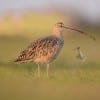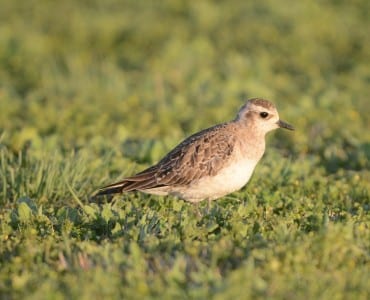 By Jim Stevenson,
By Jim Stevenson,
Please don’t forget the Saturday field trip in five days. April is here and so are the birds! This Saturday we are all over the West End of the Island, including a few secret places. $30, 8-4 pm.
I need for everyone who is interested in the Great Plains Trip to contact me IMMEDIATELY (except RM, MV and AD). URGENT!!!
Today’s article details the shorebirds we know as “grasspipers,” those who spend a fair amount of time in pastures and fields. Texas really has them!


There is a little variation in goldens, and this bird is beginning to get the black and gold speckling of its breeding plumage, and the dark ear is more prominent. This species is sometimes found near the shoreline, but they are more often among thegrasspipers, in fields and pastures.

In flight, goldens really don’t show a lot of anything but brown. This is a great color for the High Arctic, the Pampas of southern South America, and the pastures ofthe Great Plains of our Country they migrate north through in spring. Fall sees them flying east to the Atlantic and down that ocean for thousands of miles to the Patagonia area. It would be interesting to see how many hours of daylight they experience each year, as opposed to darkness!

Sometimes found in grassy habitat, especially in late spring, Black-bellied Plovers are more often true “shore” birds as opposed to grasspipers. They are larger and grayer than goldens and the black in the “wing-pit” is unmistakable. They have a pretty long migration themselves, being found down the Pacific Coastline way down South America.

Killdeer are plovers that pretty much stay in grassy areas, and even breed there, like this bird. Under her are two chicks and they look like little replicas of mom (and dad and mom look alike, too). Killdeer eat almost exclusively insects and a few other invertebrates, which is why northern birds have to head south for the winter. Their rings are ruptive marks (like many otherplovers) which break up the bird into pieces, making our hero not appear like a bird.

Upland Sandpipers are confirmed grasspipers as they are almost never seen off grass (like some of my college buddies). They are golden plover-sized but thinner (in fact, like *I* was in college). These do not nest in Alaska nearly as much as the Great Plains, so they pass through in late March and early April. If you know the note, you can often hear them calling under cloak of darkness, if you live near proper habitat. This species has also had a name change. For many decades they were known as the Upland Plover, perhaps due to the largeeyes and short bill. But they are clearly a sandpiper, and were re-named about thirty years ago. Everyone who is really tired of all the name changes, please raise their hands.

Pectoral Sandpipers are brownish as well but they have a white belly and their brown, streaked chest ends abruptly. It’s their best field mark. On the breeding grounds they will puff out these feathersto court, giving them their rather odd name. These birds are Dunlin-sized, well larger than peeps.

One peep which is often found in grassy fields, though they hide well, is the Baird’s Sandpiper. The black legs tell you it’s not a Least and you can even see the breeding plumage coming in on the back. Like most sandpipers, Baird’s nest on the Arctic Tundra and the amazing flyingability of shorebirds allows mostto nest in the Far North and winter below the Equator.

Buff-breasted Sandpipers are essentially large peeps that really prefer dry dirt fields even more than grasslands. They are mostly late spring migrants and usually drop in well inland. A few slip back through in early fall, when they aren’t nearly as buffy as this spring plumage. This one is standing on top of large dirt clods a tractor turned over.

Long-billed Curlews are winter residents on the Texas Coast in many forms of grassland – even yards – and their bill makes them unmistakable. This one has a very long beak and is therefore a female. Likemost grasspipers, they get quite brown thistime of year, great camouflage for life in the grasslands. Sorry about that Whimbrel (?) that walked into the picture.

Whimbrels prefer mudflats in early spring, looking for fiddler crabs, but then become common in grasslands when they resume migrating. Their billisn’t as long as the preceding curlew but the dark stripes overthe crown are unmistakable. This species used to be called Hudsonian Curlew decades ago but Peterson encouraged this change. Many of our birds have been re-named to match Old World names.

Marbled Godwits spend the winter along the coast in the Deep South before migrating to the Short-grass Prairie of the Inland West. In the second half of the migration, they show up in rice fields, showing off their subtle color enhancement reached slowly around the beginning of April. Many waterbirds have two-toned beaks, as the black tip’s melanin stiffens the bill so they can probe and spear fish withoutwearing out the tip.

The king of our shorebirds is the mighty Hudsonian Godwit, much more colorful than the Marbled. They are such strong fliers they rarely stop along the coast, preferring to fly inland to the rice fields. Like most Arctic birds, they migrate up in late spring – well into May – so the snowwill have melted. This bird is taking oil from his gland and coating the feathers for the overland flight.

Ruddy Turnstones are ploverish on the outside and a sandpiper internally but they certainly aren’t tied to the water. All winter they are more easily found on rocks and wharfs and in late spring they take to the sargassum that washes in. Butwhen they begin to migrate, they will drop in on rice fields and join the cacophony of other grasspipers. Behind this breeding-plumaged bird is one more in winter plumage. Like people and puberty, not all members within a species reach sexual maturity at the same time, with the greatest variable apparently being the latitude of the breeding range. I absolutely love grasspipers!

 Posted in
Posted in 






















